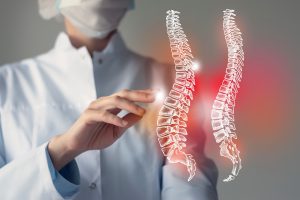An injury to the spinal cord can be life-changing. Following an accident, you may be wondering, if it is possible to make a personal injury claim for spinal cord injuries.
This guide will examine the eligibility criteria for making a personal injury claim for spinal cord injuries. It looks at who owes a duty of care in the workplace, on the road and in public places. If this duty of care is breached, causing an accident that leads to spinal cord injuries, then those harmed could be eligible to pursue a compensation claim.
We will also provide examples of evidence that could be used in a spinal injury compensation claim and also look at how compensation for an injury such as this may be calculated.
At the bottom of this guide, you will see how our solicitors could take on your spinal injury claim on a No Win No Fee basis and all of the advantages this presents to you as a claimant.

For advice, more information, or to potentially make your claim, you can speak to one of our advisors:
- Via phone on 0800 073 8801
- Via our contact us form
- Via the Live Chat on this webpage
Select A Section
- When Could You Make A Personal Injury Claim For Spinal Cord Injuries?
- Examples Of How A Spinal Cord Injury Could Be Caused
- Evidence Supporting A Personal Injury Claim For Spinal Cord Injuries
- How Much Compensation For A Spinal Injury Could You Claim?
- How A No Win No Fee Solicitor Could Help You
- Learn More About Back And Spinal Cord Injury Claims
When Could You Make A Personal Injury Claim For Spinal Cord Injuries?
When making a personal injury claim for spinal cord injuries, there are requirements that must be met before you can start a claim. We will cover these in more detail in the section below, but as a general rule, you will need to:
- Show you were owed a duty of care by a third party at the time of the accident.
- Demonstrate that this duty was breached.
- Prove this breach caused your spinal cord injury.
As with any other personal injury claim, the time limit for initiating proceedings is governed by the Limitation Act 1980. In most cases, you will have 3 years from the accident date to start legal proceedings. In some circumstances, there are exceptions that can apply.
Our advisors can offer a further explanation of the time limits for personal injury claims and advise you as to whether any exceptions apply to your case. You can contact them via the details above.
Examples Of How A Spinal Cord Injury Could Be Caused
Below you will find an explanation of the laws governing safety at work, on the road and in public places. We have also included some illustrative examples of how breaching a duty of care can cause injury, and how this can form the basis of a spinal accident claim.
A Personal Injury Claim For Spinal Cord Injuries After A Road Traffic Accident
Under the Road Traffic Act 1988, road users owe one another a duty of care to prevent each other from experiencing harm. A breach of this duty can result in a car accident.
As an example, a drunk driver misjudges a bend at a junction, colliding with a cyclist. The cyclist is knocked from their bike, suffering a sacral spinal cord injury and resulting in partial paralysis.
A Personal Injury Claim For Spinal Cord Injuries After An Accident At Work
The Health and Safety at Work etc. Act 1974 places a duty on employers to take all reasonable steps to ensure the health and well-being of all employees at work. This can include, where necessary, providing the correct training, and personal protective equipment (PPE), conducting regular maintenance of work equipment and ensuring risk assessments have been carried out properly. A failure in this duty can cause an accident at work resulting in harm such as a spinal injury at work.
For example, warehouse staff are using a forklift to move products for shipping. The forklift was flagged for maintenance, but those works have not been carried out, and the employees have been instructed to use the forklift regardless. The lifting gear fails, dropping a heavy object onto a worker, and severely crushing multiple vertebrae in the lumbar spine.
A Personal Injury Claim For Spinal Cord Injuries Caused In A Public Place
Public places can include the road network, shops, leisure facilities, parks and gardens. The Occupiers’ Liability Act 1957 establishes the duty of care that the party in control of the land owes to visitors to ensure their reasonable safety.
A spilt liquid has been reported in a supermarket. There has been no effort to clean this up or signpost it as a hazard. A shopper fails to notice the spillage, slips and injures their back. At the hospital, they are diagnosed with fractured vertebrae.
Evidence Supporting A Personal Injury Claim For Spinal Cord Injuries
You will need to prove that a third party’s negligence caused your injuries. Assembling a thorough body of evidence will help you do this. We listed some possible evidence you could gather below. This list is intended to provide guidance on the sorts of evidence you could gather, not act as a checklist. If, for example, there were no witnesses, you can still make a claim if you have other types of evidence.
- You should always seek medical treatment following a suspected spinal injury. This is important for your health: your medical records, such as any scans or test results, can be used as evidence.
- Keeping a diary during your treatment of your symptoms can be important for illustrating your physical and mental state.
- Video footage, such as CCTV or dash cam footage, can show how the accident occurred and what caused it.
- Witnesses: take down their contact information.
Get in touch with our advisors. After assessing the validity of your claim, they could then connect you with one of our solicitors. A solicitor could provide assistance with the collection of evidence.
How Much Compensation For A Spinal Injury Could You Claim?
Following a successful claim, you will receive personal injury compensation. There are two heads of claim that can make up a personal injury settlement; general damages which are awarded for the physical pain and suffering of your injuries, and special damages, which are awarded for monetary losses incurred from your injuries.
The Judicial College Guidelines (JCG) is a publication that contains guideline award brackets for various injuries, some of which are contained in the table below. A solicitor can use the JCG alongside any medical documents to calculate the potential value of your injuries.
It is important to note that this table has been included as a guide only, as personal injury claims are assessed on an individual basis.
Compensation Table
| Injury | Severity | Description | Guideline Brackets |
|---|---|---|---|
| Paralysis | (a) Tetraplegia | At the top end of the bracket will be cases where physical pain is present or a significant effect on senses or ability to communicate. | £324,600 to £403,990 |
| (b) Paraplegia | The award within this bracket will be affected by: the level of pain, degree of pain, life expectancy, depression and impact on sexual function. | £219,070 to £284,260 | |
| Neck Injuries | (a) Severe (i) | Incomplete paraplegia or permanent spastic quadriparesis, or where despite wearing a collar day and night for a period of years, there is little to no neck movement and severe headaches. | In region of £148,330 |
| (a) Severe (ii) | Serious cervical spine fractures or disc damage giving rise to disabilities of considerable severity, such as permanent brachial plexus damage. | £65,740 to £130,930 | |
| (a) Severe (iii) | Fractures or dislocations or severe soft tissue damage leading to significant permanent disability and chronic conditions. | £45,470 to £55,990 | |
| Back Injuries | (a) Severe (i) | Damage to spinal cord and nerve roots causing severe pain and disability. | £91,090 to £160,980 |
| (a) Severe (ii) | Nerve root damage with loss of sensation, impaired mobility, bladder and bowel function. | £74,160 to £88,430 | |
| (a) Severe (iii) | Disc lesions or fractures, or soft tissue injuries leading to chronic condition such as continuing severe pain and discomfort, impaired agility and sexual function, and personality change. | £38,780 to £69,730 | |
| (b) Moderate (i) | Compression/cruch fracture of lumbar vertebrae with substantial risk of osteoarthritis and constant pain and discomfort. | £27,760 to £38,780 | |
| (b) Moderate (ii) | Prolapsed discs necessitating laminectomy or resulting in repeated relapses. | £12,510 to £27,760 |
Special Damages
Special damages, the other of the two heads of claim that can make up your settlement, can be awarded for any monetary losses you experience because of your injuries. Some examples of financial losses that you could claim for are:
- Domestic care: spinal injuries can affect your mobility. You could potentially claim back the cost of any domestic support.
- Home alterations: such as shower rails or stairlifts.
- Transport costs: if your ability to drive has been reduced, you could claim back the cost of public or private transport.
- Loss of earnings: You could claim for the pay you have lost during your recovery.
How A No Win No Fee Solicitor Could Help You
Our team of advisors can provide you with an assessment of your potential claim. If your claim is deemed valid, our team could then connect you with one of our personal injury solicitors.
Our solicitors can offer you a type of No Win No Fee contract, the Conditional Fee Agreement or CFA. Under the terms of the CFA, there are generally no upfront fees nor any ongoing fees as your claim progresses. You will not have to pay the solicitor for the work they have done on your case if the claim fails.
A successful claim will see you awarded personal injury compensation. The solicitor will take a percentage of this as their success fee for their services. The percentage is legally capped, so you will keep most of your settlement amount.
To speak to an advisor and find out more about potentially starting a claim, you can contact our team:
- Via phone on 0800 073 8801
- Via our contact us form
- Via the Live Chat on this webpage
Learn More About Back And Spinal Cord Injury Claims
For more of our spinal cord injury claim guides
- Guidance on the average payout for a back injury at work
- Read our guide on paralysis compensation claims
Further Resources
- NHS – Paralysis
- GOV – Statutory Sick Pay
- NHS – Back Pain
Thank you for reading our guide on making a personal injury claim for spinal cord injuries. You can speak to our advisors for more information.



